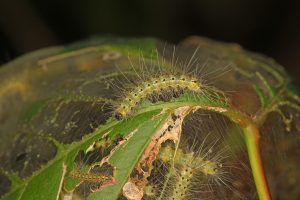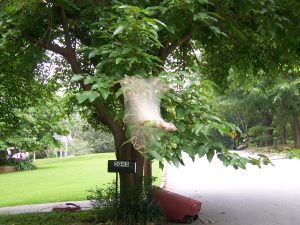Have you noticed large, messy webs on trees? You may have seen a colony of fall webworms. These caterpillars hatch in mid-July but tend to become more noticeable as the summer progresses. They often eat branches bare of leaves but are they a threat to tree health?
What do they look like?
Fall webworms are small, fuzzy pale-yellow caterpillars (figure 1) that build large, conspicuous white webs in trees in the late summer (figure 2). Their webs stretch over tree branches and grow over the course of the summer. When disturbed, the caterpillars will violently thrash back and forth in a bid to ward off predators.
- A colony of fall webworm caterpillars feeding on a leaf. Note that the web covers the leaves they are currently eating. Photo by Judy Gallagher.
- Trees will often have multiple fall webworm webs on them. This photo shows a typical number of webs for a large tree. Notice that the webs tend to be on the ends of branches and that the leaf damage is concentrated close to each web. Photo by Ken Gibson.
What kind of damage do they cause?
Fall webworms eat the leaves of many species of deciduous trees and bushes. This damage occurs late in the summer shortly before the trees normally drop their leaves for fall. Therefore, fall webworms very rarely do serious damage to trees. In most cases the trees will grow their leaves back the following spring. On rare occasions, a tree that is already highly stressed may be further weakened by fall webworm damage. However, most trees, even heavily infested trees, are minimally affected and show no signs of damage the following spring.
Do they need to be managed?
Fall webworm damage generally looks much worse than it is. In general, trees only need to be managed for fall webworm if the owner is concerned about aesthetics. In that case, the easiest means of management is pulling the web off the tree by hand and putting it in a bucket of soapy water or freezing it. Some people may be sensitive to the caterpillars’ hairs so gloves should be worn to prevent contact.
In cases where the webs are too high up to be reached, they can be managed through insecticides. Further instructions can be found here.
Cover image by Photo by msumuh on flickr.
Resources:

